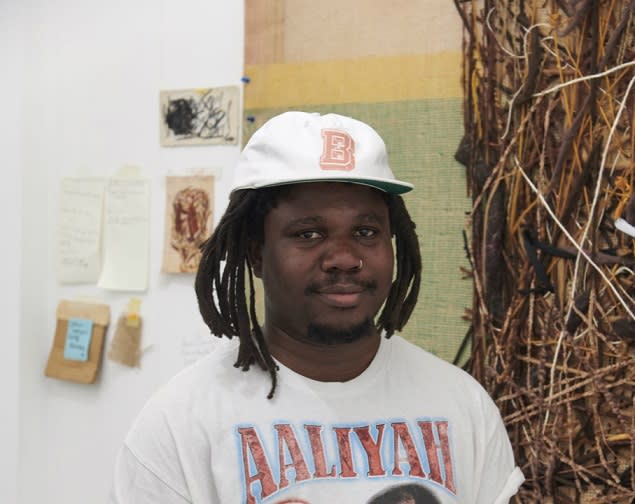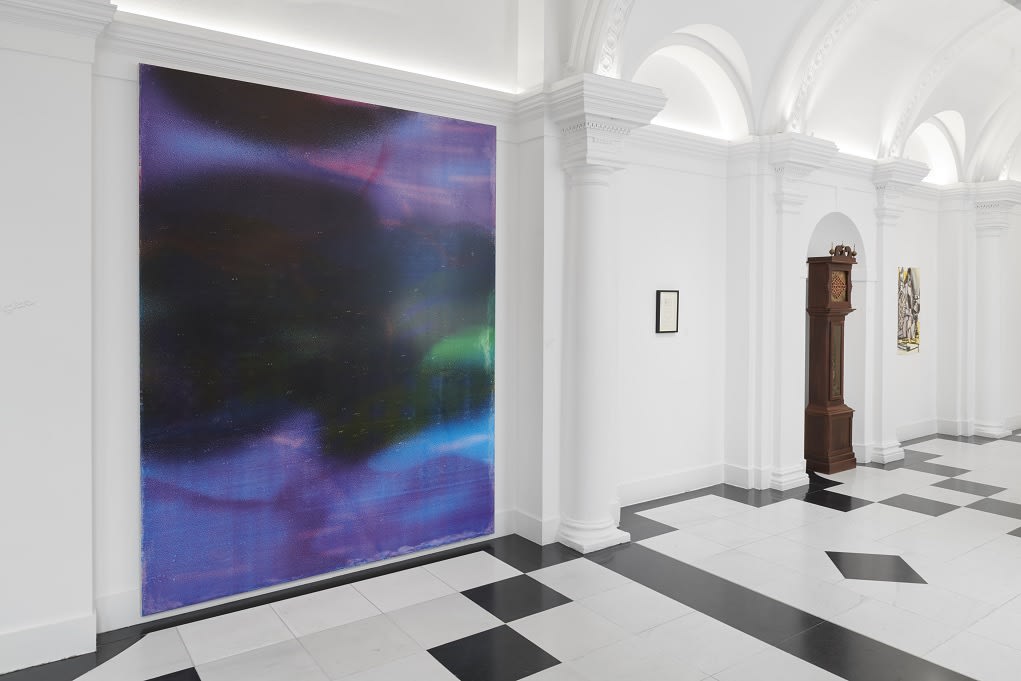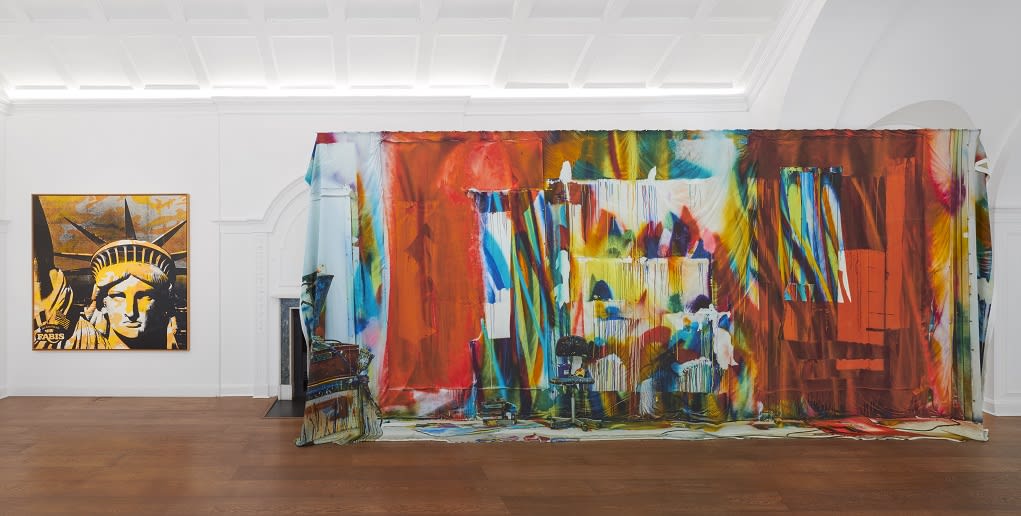
Alvaro Barrington

In ARTISTS I STEAL FROM the 36 year old artist Alvaro Barrington and Julia Peyton-Jones, the very well appreciated contemporary art curator, bring together works by 49 artists who influence Alvaro's work. The exhibition is at Galerie Thaddaeus Ropac in London from 5th June to 9th August 2019.
Alvaro, you are from Venezuela?
My parents met there, and after my mom got pregnant the family moved to New York. I moved to Grenada to live with my grandma, to have a real childhood. My parents separated and my mom remarried. When I was 8 I went to Brooklyn to be with her, but she passed away when I was 10.
What kind of a child were you?
I was a lot of different things, but after my mom died I became a very quiet kid who would draw a lot. That was the thing everybody around me celebrated. I always drew, and eventually I realized there's a world out there that supports people who make things.
When did you decide that art would be your career?
It was after I went to Hunter College on Lexington Avenue, which has a great art program with a lot of visiting artists. Carroll Dunham the painter said, "If you hate an artist you should understand why, and if you love an artist you should understand why. And you should go look at every show at every gallery." I started by making bad versions of paintings by the people I love, like Anselm Kiefer and Francis Bacon. They're all in the garbage
Why?
Because painting is a language, and you can't just land in Germany and expect to know the language. You learn the language by studying people who are great at it and understanding what the language is.
When did you do work you thought was good?
It was the last painting I made as an undergrad. I thought: OK, I've digested so many things. Let me try to throw it into a painting and see what I get. I made a painting of this guy who had a hairy arm. I squeezed tubes of paint and it began to slide down the canvas in this really gross way, and at that moment I realized the possibility within paint, that it was mobile and had life and fluidity. But that was after ten years of copying people and writing notes about what they were doing.
"For me, art school really happens in museums and galleries."
In London you have co-curated this exhibition called Artists I Steal From?
Yes. 49 artists, such as Etel Adnan, Joseph Beuys, Louise Fishman, Philip Guston, Willem de Kooning, Chris Martin, Elizabeth Peyton, Robert Rauschenberg, Trevor Shimizu, Cy Twombly, Andy Warhol and Purvis Young. Some of them are very well known and some less so, all are treated in the show as being at the same level. It could have been 600, there are so many great artists. For me, art school really happens in museums and galleries.
How would you describe this exhibition?
It's the education I wish I had. Art schools should say: Let's go down to the Met and look at this painting. Let's spend half of the week just looking at Paolo Uccello or Louise Fishman or Etel Adnan or Jean-Michel Basquiat or Anselm Kiefer. What are they doing? Why is that a successful painting? Why are they here? Why are they in front of me? Is it just some random scheme, or are they actually doing something brilliant?
Your own work in the show is called Unc You the Plug and is made of canvas and rags and yarn. How come?
It's a portrait of my experience over the past two years. There's an orange plug and a cord in there that I got from when I was down in Florida at Robert Rauschenberg's house.
Do you find a common thread between artists like Kiefer and Rauschenberg and Basquiat?
I take from all of them. In that one painting is everyone from Aaron Douglas to Jacob Lawrence to Rashid Johnson. There are some images of Grenada. Matisse is in there. Ultimately it's a composition.
Why have you stitched together rags and canvas?
Chris Ofili used elephant dung in his painting as a way to throw himself off, as a way to resolve the question: How do I put elephant dung in the painting that makes you look at it and not think, Oh that's elephant dung? I need to throw something in the painting that I have to resolve, and I remember my auntie sewing, and so I thought I could use sewing as a way to throw me off, as a way to resolve the fact that I didn't know how to make an interesting portrait.
Will Alvaro Barrington be remembered for sewing and yarn?
I hope that history never remembers me as using yarn! You learn that artists did this one thing, but when you see their long history you go: How come they didn't tell me about this? That's a huge disservice that we do to artists. Picasso was smart in that he was able to figure out how to change, but most artists were very diverse.
"I need to throw something in the painting that I have to resolve."
You are a younger generation than people like Urs Fischer, Dan Colen, and Mark Grotjahn. Does their work interest you?
I love Mark's work. How he is able to fit so much into every line is really brilliant. Also artists like Jonas Wood.
As a young artist, how did you come to work with the well-known curator Julia Peyton-Jones?
I feel very privileged. People saw me around for a long time and remembered me. If you're consistent you are supported, and there were artists in my community who knew certain dealers and they said: Hey, this is a young artist. I think you should check him out.
Which is your community?
Teresa Farrell and Richard Kuan and I used to go to MoMA and look at one painting for eight hours.
You were born in Venezuela but are very much from Brooklyn?
I think of myself as being from Brooklyn because I have been there for 30 something years. It's a ten minute bike ride from my house to my studio, and each and every corner means something to me. That's the corner that I made out with that girl, or that's the corner that I got into an argument with my ex-girlfriend. By the time I come to the studio I have to unwind from all these experiences, because when I'm in the studio it's about being present with the work and the painting.
Do you always work alone in your studio?
It's about me being in conversation with that painting. Sometimes Teresa and I will collaborate and she'll be there, but I have no assistants.
How many hours do you work?
Sometimes I'm in the studio for two weeks by myself. I work on a lot of different things. I take no showers. I don't go home. Nobody comes in and I'm just there, and after two or three days food and deodorant is delivered and clean socks, which is really important. I have a bad phone addiction, but most of my friends don't message or call me because they know I am working.
"Social media is this false thing that's happening over there."
What is the job of an artist?
Our main job is to tell our stories, and a new generation will always find a way to connect what they're going through to who they are.
Is art accessible to everybody?
For a long time art was a space that was generated to make people feel dumb. Either you were naturally gifted and you had it, or you didn't. But it is accessible, it's something that's part of our capacity to learn; to look, to see, to be. Basquiat, Kiefer or Baselitz isn't some big god in the sky, but a human being that we all could take from and learn from.
What is your next project?
I have a collaboration show with my friend Teresa opening at Emalin in Shoreditch, where we are doing a bunch of parties. I'm doing a Notting Hill Carnival float and a party. We're opening the first of a multi-chapter ten year project between Sadie Coles and Corvi-Mora. With Ropac in Paris we're doing parties with a bunch of free concerts about Paris and fashion, and black people and fashion.
Is there still a lot of racial discrimination?
Things are moving forwards and things are moving backwards, but human beings are always shifting ideas of ways to discriminate against each other. We've been the same for as long as we've been on this planet.
Do you mean that nothing really changes?
I am optimistic. Life is really beautiful and people who are oppressed will always find a way to remove that oppression. We're people who are only aware of our own self, who can through empathy and love learn how to love other people. But that's a trained capacity.
Does social media influence your work?
Social media is this false thing that's happening over there. I am on Instagram, but there's something much more real about this conversation and about me being in front of a painting.
Do you worry about the impact of technology?
Right now technology is that big oppressive force, but kids will learn how to become free through technology. Algorithms spread fake news and tell people how to feel, but kids who were formed in this era will see the flaws within that system, challenge it and figure out how to get back to their humanity.
Is humanity stronger than its inventions?
Yes. That's part of our DNA.
London. June 2019
Installation views, ARTISTS I STEAL FROM, curated by Alvaro Barrington and Julia Peyton-Jones, Galerie Thaddaeus Ropac, London, 5th June – 9th August 2019.
© the artists, courtesy Galerie Thaddaeus Ropac, London, Paris, Salzburg.
Photos: Ben Westoby

Unc you the plug 2019 by Alvaro Barrington, including painted wooden stretcher bars, burlap in place of canvas, yarn, coloured paper, pen/pencil notes on paper, coloured pins, an orange plug and cord taken from his Rauschenberg residency on Captiva Island and two du-rags (one white, one black).
© Alvaro Barrington, courtesy Galerie Thaddaeus Ropac, London, Paris, Salzburg. Photo: Ben Westoby





